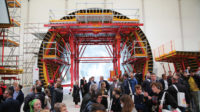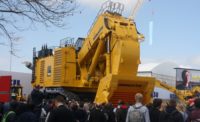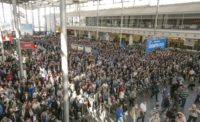The latest in construction equipment was on display in Munich on April 11-17 during the triennial Bauma equipment show. Updated machines, with the latest in integrated telematics and other high-end features targeted at developed global markets, were on display for over 580,000 visitors from 200 countries.
Often seen as a European equipment show, this year’s Bauma saw a global mix in its 3,423 exhibitors, with 63% coming from outside Germany. It was the largest Bauma by attendance in the show’s history, according to the organizers, Messe München.
But despite record attendance and massive displays from the world’s biggest equipment makers, analysts say sales in construction are expected to remain flat. “I doubt we’re going to see a whole lot of long-term growth just based on the Bauma show,” said Chuck Yengst, of analyst Yengst Associates, in a conversation with analysts at investment firm Stifel Nicolaus. Yengst expects construction machinery sales to remain flat or even slip in some categories over the next few years, with rental to continue as an strong option for contractors still worried about long-term prospects.
Big product launches at Bauma were keyed toward European and North American markets. With economic slowdown in China, Brazil and other developing markets, equipment makers are pushing feature-heavy machines for developed markets.
“We need to expand our presence in North America and Europe,” says Makoto Kato, managing director for Kobelco Europe. “We will maintain stable shares in China, Japan and Southeast Asia, but we see opportunity in Europe.” Kobelco reentered the European market in early 2014, and Kato sees strong growth potential for Japan-based Kobelco.
One high-end Kobelco machine on display was its new hybrid excavator, the SK210-C, which was unveiled earlier this year. The machine is a departure from Kobelco’s earlier hybrids. The old models stored leftover power from the duty cycle in capacitors, which would discharge during return-to-dig to conserve fuel. But capacitors discharge too quickly. Kobelco’s new approach uses batteries instead of capacitors, offering more consistent power.
Crane maker Manitowoc took the opportunity at the show not only to show the latest Grove, Manitowoc and Potain cranes, but also to outline a new corporate strategy following the spilt from its food-service business in March. The company launched several new cranes at Bauma, including a self-erecting crane from Potain. The first in Potain’s new Hup range, the Potain Hup 32-27 boasts a 32-meter jib radius and a 27-m height. The crane features an offset jib, reducing the overall footprint of the crane. “The jib is offset from the boom, and that’s a new concept for the self-erecting crane market,” says Larry Weyers, Manitowoc executive vice president for tower cranes. The offset jib allows for the whole crane to fold down for transport in a single shipping container, says Weyers.
Despite the selection of innovative products on display, new Manitowoc CEO and President Barry Pennypacker emphasized that the new company will have to pick and choose which R&D ideas it chases down.
“We don’t need to have the most state-of-the-art, crazy invention that sometimes goes out into the field with reliability issues, and then you have to deal with that for years,” Pennypacker said. “Innovation is in everything we do. But innovation doesn’t mean you have to have the newest computer object on the crane or on the device or service you are selling. What it means is, you have to be innovative in all your business processes.”
In a sign rental markets are still hungry for larger and larger boom lifts, JLG announced it sold the first of its new 1500AJP articulating boom lifts to European rental giant Riwal. The 1500AJP has a 158-ft working height, the tallest in the market. It will be available in 2017.
One of the biggest draws at the show was the massive 667-ton mining excavator at Komatsu’s outdoor booth, with many attendees climbing into its giant 47-cu-yd bucket for Bauma selfies. The PC7000 mining excavator was the largest piece of earthmoving equipment at the show—according to Komatsu.
The company also took the occasion to highlight its own updated hybrid excavator, as well as an expansion of its Komtrax telematics system and intelligent dozers. The new dozers are just the latest addition to Komatsu’s intelligent machine-control machines. Introduced at Bauma 2013, the iMC machines have performed better than expected, with over 2,450 units sold worldwide. Greater use of intelligent machines is a focus for the company, says Komatsu UK Boss Peter Howe. “We’ve collected all this data through Komtrax [telematics], and now we can make the job processes easier,” he says.
With persistently soft equipment sales, manufacturers are seeing telematics and fleet management as ways of keeping customers invested in their brands, as well as securing subscription fees. Recent AEMP standards on telematics data-sharing prompted Caterpillar, Case Construction and others to relaunch their fleet-management web software at Bauma to allow for mixed-fleets. “Now, with the AEMP standard, you can see your entire fleet in one place with Cat VisionLink,” says John Thomas, Cat marketing director for virtual site solutions. “If you’re already using telematics, not having to switch between software is huge.”
Specialty manufacturers targeting heavy industry did report some positive news. TII Group, which manufactures the Scheuerle brand of self-propelled mobile transports and other high-capacity, over-the-road trailers, says industrial activity in North America remains strong enough for them to introduce new models to the market. Transporting massive, prefabricated components for power plants and heavy industry is still a steady business for TII Group, which reported 270 million euros (approximately $305 million) in revenue for 2015. Axel Müller, TII Group CEO, says, “2016 is already very good, and we expect to have a roughly similar figure this year.”
TII has grown its business in the United States, designing heavy transport systems specifically to comply with U.S. over-the-road restrictions. A new heavy-load trailer from the company is capable of adjusting its width from 16 ft to 20 ft in order to comply with various state regulations. The company is also reporting strong sales on the Scheuerle MES highway trailer, which boasts a 115-ton capacity and has its axles in groups of three to meet on-highway regulations. “It’s a very nice design for dealing with road restrictions in the U.S.,” says Bernd Schweingbier, TII Group sales director. “With this trailer you can go from Houston straight to Fort McMurray.”
And as a reminder that Bauma has something for everyone, new specialty demolition products were on display in Munich. Swedish manufacturer Brokk’s preview of a new compact remote-control demolition robot January’s World of Concrete proved to be an appetizer for a larger, more robust addition to its lineup—the 280. Designed for use in extreme work environments, the 6,945-lb diesel-powered machine features a reach of more than 20 ft and hardened-steel front body panels that also help safeguard the machine’s LED headlights.
Given the nervousness in the global construction market, Bauma’s organizers were relieved by the large crowds. “Many exhibitors are talking about a record level of demand at Bauma 2016,” said Klaus Dittrich, CEO of Messe München. “And that is an extremely positive sign in this current uncertain climate.”
But Yengst took a more realistic view. “Roughly a third of [exhibitors] had ‘new’ plastered all over the place,” he noted. But with the Tier 4 engines migration nearly done, the new features are “just whistles and bells in my opinion.”
By Jeff Rubenstone in Munich, with Jim Parsons














